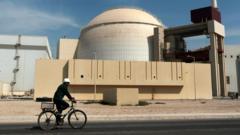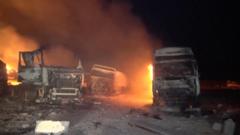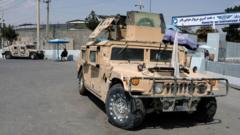With tensions escalating since the US withdrew from the nuclear deal in 2018, both countries find themselves in a complex standoff regarding Iran's nuclear intentions and the potential for military intervention.
Iran's Nuclear Ambitions: The Impasse between Tehran and Washington

Iran's Nuclear Ambitions: The Impasse between Tehran and Washington
In ongoing negotiations in Muscat, Oman, the US and Iran explore resolutions to the contentious nuclear program issue.
---
US and Iranian officials are currently engaged in indirect talks in Muscat, Oman, aimed at resolving the ongoing tensions over Iran's nuclear program. The last few years have been tumultuous; in 2018, President Donald Trump withdrew the US from the Joint Comprehensive Plan of Action (JCPOA), the previous nuclear agreement that aimed to limit Iran's nuclear activities in exchange for the lifting of sanctions. The withdrawal reinstated stringent economic sanctions against Iran and heightened fears over military conflict.
Iran maintains that its nuclear program serves peaceful purposes, yet many nations, including the International Atomic Energy Agency (IAEA), express skepticism. This skepticism dates back to 2002 when secret nuclear facilities were discovered, violating the Nuclear Non-Proliferation Treaty (NPT) that Iran had signed. While the NPT permits non-military nuclear technology, it strictly prohibits the development of nuclear weapons.
Since the US exited the JCPOA, Iran has ramped up its uranium enrichment, breaching previous commitments. Reports indicate that as of March 2025, Iran possessed roughly 275kg of uranium enriched to 60% purity, a significant leap from the earlier allowed limit of 3.67%. This enriched uranium could theoretically be further processed to produce several nuclear weapons within a matter of months, raising alarms among US officials who estimate that one weapon could be developed in as little as a week.
Trump's rationale for withdrawing from the deal was rooted in frustrations over its temporary nature and lack of provisions for Iran’s ballistic missile program. The situation escalated tensions regionally, particularly with allies like Israel, which perceives Iran as a direct threat. Israel's prime minister insists that any acceptable agreement must involve dismantling Iran's entire nuclear program.
As negotiations continue, Iran seeks to reach a compromise to limit its nuclear capabilities while lifting sanctions, contingent on the US securing a promise to forego military options. The stakes remain high, as both US and Israeli military capabilities pose a potential threat to Iran’s infrastructure, though the execution of any military action would face significant challenges.
While discussions seem to be occurring at a slow pace, the involvement of regional players and the potential for unforeseen consequences make the outcome uncertain as both sides head into sensitive negotiations.
US and Iranian officials are currently engaged in indirect talks in Muscat, Oman, aimed at resolving the ongoing tensions over Iran's nuclear program. The last few years have been tumultuous; in 2018, President Donald Trump withdrew the US from the Joint Comprehensive Plan of Action (JCPOA), the previous nuclear agreement that aimed to limit Iran's nuclear activities in exchange for the lifting of sanctions. The withdrawal reinstated stringent economic sanctions against Iran and heightened fears over military conflict.
Iran maintains that its nuclear program serves peaceful purposes, yet many nations, including the International Atomic Energy Agency (IAEA), express skepticism. This skepticism dates back to 2002 when secret nuclear facilities were discovered, violating the Nuclear Non-Proliferation Treaty (NPT) that Iran had signed. While the NPT permits non-military nuclear technology, it strictly prohibits the development of nuclear weapons.
Since the US exited the JCPOA, Iran has ramped up its uranium enrichment, breaching previous commitments. Reports indicate that as of March 2025, Iran possessed roughly 275kg of uranium enriched to 60% purity, a significant leap from the earlier allowed limit of 3.67%. This enriched uranium could theoretically be further processed to produce several nuclear weapons within a matter of months, raising alarms among US officials who estimate that one weapon could be developed in as little as a week.
Trump's rationale for withdrawing from the deal was rooted in frustrations over its temporary nature and lack of provisions for Iran’s ballistic missile program. The situation escalated tensions regionally, particularly with allies like Israel, which perceives Iran as a direct threat. Israel's prime minister insists that any acceptable agreement must involve dismantling Iran's entire nuclear program.
As negotiations continue, Iran seeks to reach a compromise to limit its nuclear capabilities while lifting sanctions, contingent on the US securing a promise to forego military options. The stakes remain high, as both US and Israeli military capabilities pose a potential threat to Iran’s infrastructure, though the execution of any military action would face significant challenges.
While discussions seem to be occurring at a slow pace, the involvement of regional players and the potential for unforeseen consequences make the outcome uncertain as both sides head into sensitive negotiations.























